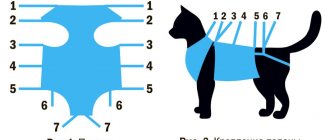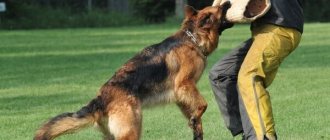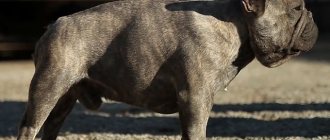Difficulties in training a Labrador
Labradors are one of the smartest dog breeds. They often learn a command 2-3 times, remembering it for the rest of their lives. Learning ability persists into old age.
Problems include impulsivity: Labradors are easily distracted and often try to run away to play. Sometimes they try to use cunning to get more treats for a minimum of work. Due to their character traits, Labradors are easy to train as companions, hunters, guide dogs, and detectives, but security skills are difficult for them.
Features of Labrador Retrievers
Labrador Retrievers are unique dogs that were originally bred as hunting gundogs, but are now often found both as companion dogs and in service in various government departments. Dogs of this breed are well trained and have an easy-going disposition.
Excellent ability to distinguish odors allows Labradors to be used in the search and rescue service, as well as in the search for narcotic and explosive substances. This is also facilitated by the almost complete absence of aggression towards people, which allows them to be used in crowded places and on public transport.
The Labrador's character is reflected in his eyes: look, the world is beautiful, I love everyone and everyone loves me. Labrador is charged with optimism and cheerfulness, good nature and playfulness. In the family they create an atmosphere of home comfort and harmony. Labradors are endowed with considerable energy and activity, so do not forget about joint games and physical activity. This breed is distinguished by intelligence and intelligence, they are quite easy to train. The Labrador's desire to please the owner also helps in training, and he tries to carry out commands perfectly accurately.
The most suitable training courses for Labradors are:
- OKD - general training course
- Obidience
- Preparing for the hunt
Labradors are playful, but they are also prone to obesity and require significant exercise; without it, they can quickly gain excess weight, which can negatively affect their health and life expectancy. Therefore, it is necessary to carefully monitor both their daily diet and their daily activity.
For a Labrador, with the right approach, it will not be difficult to master the general training course; they are very sociable and have a pronounced need to communicate with a person, which is a huge plus when teaching them obedience commands. But it is worth remembering that these dogs get very bored without human communication, so you should not leave them alone for a long time. Even the owner’s daily absences for work are stressful for them, which should be compensated for by playing and walking together after returning from work.
The Labrador, being a hunting breed, loves to sniff out various things on the ground. Due to the fact that deliberate baiting of pets has become more frequent, we strongly recommend teaching your dog “not to vacuum” and not to pick up anything from the ground; a competent dog handler can help in solving such an important problem.
When to start training
One of the primary questions is when to start teaching your Labrador commands?
Education should begin from the first day the puppy is in the house. You need to call him by name, accompanied by the command “Come to me!” The second main command is “Place!” With this word, show the puppy the bed, and then repeat it, taking the baby to rest. Stop a prohibited action with the command “Ugh!” It is advisable to introduce the puppy to these commands in the second month of life.
We recommend this article:
11 must-have commands for dogs and extraordinary tricks
The most fruitful age for learning is 3–6 months; later learning ability decreases slightly, but established habits remain, so it is important not to miss this moment.
Nuances of education
At 2 months old, your Labrador Retriever puppy is still at home, in quarantine after the first vaccinations, and he is not yet allowed to go for walks. Therefore, it’s time to start raising a puppy in familiar home conditions.
The first step is to teach the puppy to go to the toilet in a diaper. At the same time, it should be remembered that any learning is a rather complex thing, and seeing the first positive results, you should not think that your puppy has already understood everything, but you should continue training according to the method, so that after a while you do not have to start all over again.
The second important point will be to accustom the puppy to a collar and leash. Yes, yes, this should be done at home, so that by the time the puppy goes outside for the first time, wearing a collar will not be additional stress for him, but is already a familiar thing, and he can begin to explore the world around him, rather than trying get rid of an unknown object.
We invite you to read: Serengeti - a tamed and domesticated beast
The third point, which causes the greatest difficulties for new puppy owners, will be determining the boundaries of what is permitted for the puppy:
- Teach to play only with your toys, and not with your things;
- Explain that you cannot bite your hands even in a game;
- Establish the correct daily routine, establishing the rule that in the morning you need to sleep and not wake you up;
- Stop chewing furniture, clothes, walls and baseboards;
- Teach to stay at home alone, knowing that your absence is not a reason to bark or howl.
IT IS EXTREMELY IMPORTANT TO KNOW: that constant and excessive punishment following almost every action of a puppy has a detrimental effect on its fragile psyche and can lead to the Labrador Retriever puppy growing up cowardly and embittered. For normal natural development, a puppy must have the opportunity to explore the world around him, which is currently limited to your apartment or house.
You should also begin now to familiarize yourself with the initial obedience commands in a light playful form, while focusing on rewards for execution, because the puppy’s psyche is still quite plastic and excessive severity and exactingness can lead to the puppy being intimidated and cowardly. Therefore, it is necessary, first of all, to try to interest the puppy by offering him a toy or treat, and sometimes just praise.
Well-planned training is 50 percent of success. The trainer needs to remember that if there is an excess of feelings, it is difficult to achieve the dog’s obedience. And the owner’s persistence will cause emotional suppression of the pet.
Before the lesson, the Labrador should have played enough and be a little tired. A leisurely walk on a leash will distract your dog from entertainment. After 10-15 minutes you can try to call your pet. If the Labrador immediately responds to the call, it is ready for training, but ignores its nickname - the nervous system has not yet returned to its normal state.
For boys
When working with male dogs, you need to learn how to keep the dog's attention on you. The owner should give priority to dogs running past.
The hardest thing for Labradors - boys - is to resist the temptation to be distracted by a playful lady during the period of heat.
Girl
Bitches have their own difficulties. The trainer has to adapt to frequent mood swings or learn to stabilize the emotional swings of the four-legged animals. Instability is associated with hormonal levels.
Expert opinion
Anna Abramenko
An avid dog lover. Experience in veterinary medicine since 2009.
Ask a Question
When your pet becomes distracted, it is better to postpone training. The best option is to start raising a girl at 2 months.
According to research, the Labrador is not the smartest dog breed on earth. However, he remains firmly in the top ten of this list. Add to this extraordinary hard work and the result is a breed that is excellent for training.
Labradors are able to remember about three hundred human phrases. At the same time, it does not need to suppress aggression, as in some traditional fighting breeds. He can be a great friend and family member who will be friendly towards strangers.
Basic rules for training a puppy
Training a Labrador at home should be accompanied by rewards. These dogs are big gourmands, so the best reward for them will be delicious food. You can give a treat only for the correct execution of a command, not out of pity or “in advance”.
We recommend this article:
Contents and basic principles of dog training
You need to train your dog before feeding. At first, in quiet places where nothing will distract her. However, a well-trained Labrador must also follow commands on the street, among noise, an abundance of smells and in the company of other dogs, so after consolidating the skill at home, it must be repeated during a walk.
Do not move on to new commands until the dog is confident in following the previous ones. For a 2 month old baby, 5 minutes of training is enough. Gradually the time increases to half an hour. You need to end your training with success. If the current command is given to the puppy poorly, let him finally carry out the one he knows well. The training ends with the command “Walk!”
A common question is how to teach a Labrador a voice command? After all, the dog cannot be pushed to do this (just as you lightly press on the sacrum to force the dog to sit). In fact, everything is simple: command “Voice!” when the puppy starts to bark, and soon he will catch the connection.
We recommend this article:
How to properly teach your dog the “Down” command
We pronounce commands in a confident commanding tone.
Similar article: What to look for and how to choose the right Labrador puppy
You can learn a lot of useful information from books on training that describe all the steps. However, the team “Fas!” It is better to train the dog under the supervision of a canine instructor.
We recommend this article:
Basics of training or how to teach a dog the “Come to me” command
What to do if your Labrador doesn't listen
If cases of disobedience occur at a young age, then there is no reason to panic. This is being fixed. Pay attention to the obedience course and develop positive motivation in your dog for human orders.
Often, disobedience is a consequence of the owner’s misunderstanding of the dog’s needs. For example, Labradors love to sleep on a chair or sofa and do not want to rest on the floor. If you constantly push your dog off the chair, you will notice: you approach the room, hear the sound characteristic of a dog jumping off, notice that the chair is clearly warm, and the pet is lying on the floor. Alas, you taught the dog to lie. Give your dog a chair that you can sleep on. Under no circumstances should you remove your dog from his chair.
A Labrador rarely goes beyond safe behavior, but a disobedient dog can cause a lot of trouble. If you feel that your educational methods have ended or have shown failure, then contact a dog handler or animal psychologist.
We teach good manners
Let's look at how to raise a Labrador puppy.
Collar and leash
After the Labrador puppy gets used to the new place, you can accustom him to the collar. Put it on your puppy and immediately offer a toy or treat. Distract your baby when he tries to remove the collar and praise him if he doesn't do it.
We recommend this article:
How to successfully train your dog to walk on a leash
After fastening the leash, do not pull the puppy at first, follow him yourself. Gradually get used to the slight pull and the fact that he should follow you. Don't forget to reward success.
Toilet
Raising a small Labrador begins with toilet training. As soon as you see that the baby begins to sit down characteristically (after eating, sleeping or playing), take him to the tray or on a bed of newspapers. Pet him and praise him when he does it. Encourage when he learns to go to the right place himself. Praise especially actively for relieving yourself on the street. When the puppy learns to tolerate it (at about 4 months), remove the “house toilet”.
Place
Take the puppy to his bed with the word “Place!” and reward him if he doesn't try to run away. In the future, he must learn to go there himself on command. There is an important rule: the dog cannot be scolded or punished in this place. She should feel safe there.
We recommend this article:
General description and features of passing OKD for dogs
Behavior
Raising a Labrador puppy includes proper interaction with other people. Don't let your dog greet guests too loudly. Starting from three months, use the commands “Sit!” or “Place!” When everyone is seated, cancel the command and allow the dog to meet new people.
Like the retriever, this breed rarely shows aggression towards strangers, but can be trusting. A trained dog should not take food from strangers or pick it up from the ground. You can ask a friend to give the dog a piece of food with hot spices or lemon (a little so that the dog doesn’t get sick!). We stop attempts to take food from the ground with the command “Ugh!” Because of the dog hunters who spread the poison, this is important for the life of your dog.
We recommend this article:
How to successfully train a dog to give its owner its paw
Care and hygiene
You should check your puppy's ears, eyes and teeth regularly. This will help you notice problems in time, and the dog should learn to respond normally to checks from the veterinarian or at shows.
We recommend this article:
Pros and cons of keeping a Labrador in an apartment
When lifting the dog’s lips to inspect the bite, give the command “Teeth!” After a while he will begin to show them himself.
Similar article: Standard and non-standard Labrador color varieties
If the claws do not rub off on the asphalt, they need to be trimmed. Clean ears and eyes as needed.
It is important to provide your dog with a healthy, balanced diet. Unfortunately, one of the characteristics of the breed is a tendency to obesity. Your Labrador should be fed strictly according to a schedule and taken out of the room during family meals. Don't allow guests to feed your dog.
We recommend this article:
How to Choose and Use a Clicker for Dog Training
How to stop a Labrador from biting and jumping on people?
To prevent your puppy from lunging at passers-by, use one of two training methods:
- If a Labrador jumps on you when you meet him, turn your back to him and ignore him. The dog will understand that its attempts are useless and will not behave this way in the future.
- The second method can be used if the pet knows the “Fu” command. When he tries to jump on a person, he should be lightly pushed away and the above order given. A few trainings, and the animal will stop grabbing your legs and throwing yourself into your arms.
Outdoors, you can use a collar and leash to control your Labrador's actions. As soon as he tries to approach a passerby, stop and command him “Fu.” If the dog calms down, give him a treat. In order for your dog to quickly learn the rules of behavior, control him in public places, do not let him pull on the leash, keep him at a distance from other people and animals.
We reward and punish
The basic rule of rewards and punishments is that they must follow immediately after the action: a reward accompanies the successful execution of a command, punishment accompanies the moment of misconduct. Otherwise, the dog will not make the causal connection. If your baby is overjoyed at your return, and you see torn headphones and start scolding him, he will attribute the punishment to the fact that he rushed to greet you, and not to the headphones with which he played in time immemorial.
As a reward for the Labrador, pieces of boiled meat or liver, crackers (homemade, without harmful factory additives) or dog treats from the pet store will serve. Any sweets (cookies, candies) are harmful; chocolate can even be fatal.
But training a Labrador puppy should not be based only on treats. Don't forget to pet and praise your puppy. The words “Well done”, “Good boy”, “Good girl” are also important to him.
You cannot hit the dog; a strict intonation will be enough.
Team "Place"
One of the first commands a Labrador puppy should learn is the “Place” command. This need is due to the fact that it is basic for many combined teams. Learning algorithm:
- Choose for the puppy the very place to which he will be accustomed (it should be on the territory of the house - a special rug, an old pillow, a cozy house).
- Show your pet its place.
- Every time after the baby falls asleep, he must be taken to this place until the baby gets used to it.
- He needs to be placed on a mat specially designed for rest and during waking moments, voicing the command verbally.
These actions are carried out until the Labrador begins to respond adequately to the word “Place”, that is, he lies down on his mat on his own. As soon as progress is evident, the pupil is given a treat as encouragement and reinforcement of the result.
Basic mistakes
Training a small Labrador should never involve hitting or screaming. This way you will link the training with something dangerous and teach your puppy to avoid it. This is as bad as training a two to three month old puppy using a program designed for adult dogs.
Don't change teams. If you start teaching your puppy the command “Come!”, do not use “Come here!”. It is strongly recommended to use the commands in their classic form. This is also important in competitions.
Similar article: Weight of a puppy and an adult Labrador by month
Do not regret the time spent on caring and raising a puppy - your efforts will be rewarded with a loyal and smart friend!
Video “How to train a Labrador”
From this video you will learn how to train a Labrador at home.
Recommended Posts
How to care for a puppy and an adult Labrador
What is tasty and healthy to feed your Labrador at home?
What to look for and how to choose the right Labrador puppy
What kind of Labrador mixes exist in nature?
Weight of a puppy and an adult Labrador by month
Description and features of keeping a Labrador Retriever











